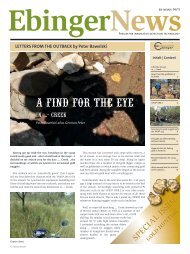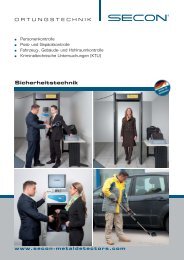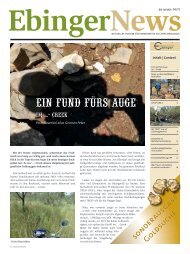unterwasser-metalldetektoren uwex® erobern den tauchsport - Secon
unterwasser-metalldetektoren uwex® erobern den tauchsport - Secon
unterwasser-metalldetektoren uwex® erobern den tauchsport - Secon
Sie wollen auch ein ePaper? Erhöhen Sie die Reichweite Ihrer Titel.
YUMPU macht aus Druck-PDFs automatisch weboptimierte ePaper, die Google liebt.
After adjustment the detector was in operation for around one hour in the field<br />
which had been already pre-inspected by another standard detector. During the<br />
work neither unknown alarm signals nor rustling alarms were noticed. On the control<br />
field an alarm signal for an object at a depth of 12 cm was received. This object<br />
had not been detected by the standard detector.<br />
The detector was used in rotation – i.e. one hour operation – one hour break<br />
- without being switched off. In the time from 6 a.m. to 2 p.m. the temperature<br />
increased from 18 °C to 32 °C and the humidity decreased so that the detector was<br />
working under normal conditions in the active detection work during this period.<br />
After a preliminary audit the detection work was started on 19.06.2010 at 6 a.m.<br />
on a mine field which had not been inspected before. The detector was then in use<br />
for around four hours.<br />
During the preliminary audit the emphasis was placed on a constant detection<br />
speed of 0.3 m per second and with the head positioned close to the ground. The<br />
detector was not switched off during this period.<br />
The report states that during the above time 6 PMAs (2 of them contact mines)<br />
were detected at depths of 3 – 8 cm. These were indicated by clear and strong<br />
alarm signals.<br />
PRODUKTINFO TREX® 204 M<br />
Das TREX ® 204 M ist eine moderne Variante der bereits vor 40 Jahren in der Kampfmittelräumung<br />
erfolgreich eingesetzten EBINGER-„Hockeyschlägerson<strong>den</strong>“. Das<br />
neue, weiterentwickelte Son<strong>den</strong>konzept des Typs TREX ® 204 M (akkreditiert durch<br />
BH-MAC) gestattet eine genaue Lagebestimmung von Metallobjekten, die in schwer<br />
zugänglichem steinigem Gelände, in Furchen, Löchern oder im Unterholz verborgen<br />
sind.<br />
Auch unter erschwerten Einsatzbedingungen schätzen Anwender diesen Detektor<br />
aufgrund seiner hervorragen<strong>den</strong> Sucheigenschaften und der guten Laufruhe auf<br />
mineralisierten, bedingt kooperativen Bö<strong>den</strong>, was von Minenräumern sehr positiv<br />
aufgenommen wird. In der humanitären Minenräumung unterstützt TREX ® 204 M das<br />
Aufspüren von oberflächennah getarnt verlegten Landminen mit geringem Metallgehalt.<br />
Blindgänger, die je nach Kaliber und Suchbedingungen in der programmtypischen<br />
Suchtiefe von 50 cm verborgen sein können, wer<strong>den</strong> ebenso erfasst.<br />
Typische Suchaufgaben, die bei der Polizeiarbeit oder auch in der Archäologie und<br />
Geologie zu fin<strong>den</strong> sind, wer<strong>den</strong> durch die präzise Lokalisation und klare Signalgabe<br />
deutlich erleichtert.<br />
PRODUCTINFORMATION TREX® 204 M<br />
The TREX ® 204 M is a modern variant of the EBINGER „hockey stick probe“ that was<br />
first put to use for the detection of explosive ordnance 40 years ago. The new and<br />
further developed probe concept of the TREX ® 204 M (as accredited by BH-MAC) permits<br />
a pinpoint location of metal objects which are concealed in stony terrain that<br />
is diffi cult to access, in furrows and trenches, channels or beneath under-growth.<br />
Even when used in adverse working conditions, users cherish this detector because<br />
off its outstanding detection properties on mineralized and only partially<br />
co-operative ground and good balance. In humanitarian mine action the TREX ® 204 M<br />
supports the detection of landmines with low metal content concealed close to the<br />
surface. ERW which is buried down to 50 cm, can also be detected depending on<br />
size and local working conditions.<br />
Typical search tasks that arise in forensic police work as well as in archaeology and<br />
geology are also significantly facilitated by the detector‘s pinpointing properties<br />
and clear signals.<br />
In addition the wires of a PMR 2A mine were able to be<br />
detected under the grass / vegetation. After the wires<br />
had been tracked for 4 - 5 m, the seventh mine could<br />
be detected 2 m next to the wire at a depth of 10 cm<br />
by a clear and strong alarm signal.<br />
The detector was then used for two further days in<br />
accordance with the procedure described above. The<br />
same SAFE results were obtained. At the end of the<br />
week the battery control lamp came on indicating that<br />
the battery needed to be recharged.<br />
In conclusion it can be noted that operation with the<br />
detector was satisfactory in all respects in spite of the<br />
high mineralization of the ground, the high initial humidity<br />
and the unstable weather conditions.<br />
In addition it has to be noted that the TREX ® 204 M<br />
was able to function properly near high-tension power<br />
lines (35 kV) while other detectors could not.<br />
ebingernews | 15








